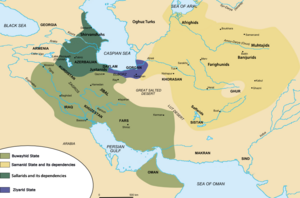Al-Hasan ibn al-Fairuzan
'Al-Hasan ibn al-Fairuzan | |
|---|---|
Simnan | |
| In office c. 960s – ? | |
| Governor of Sari | |
| In office Mid-930s – ? | |
| Governor of Tabaristan | |
| In office 930–? | |
| Personal details | |
| Children | 3+, including Fanna Khusraw (grandson) Rukn al-Dawla (son-in-law) |
| Dynasty | Firuzanid family |
Al-Hasan ibn al-Fairuzan (
Biography

Al-Hasan was the son of
In 930, Makan managed to recover Tabaristan, and appointed al-Hasan as the governor of the region. Makan also made Abu Muhammad Hasan ibn Qasim the imam of the Alids. A fake rumor later spread about the death of Makan,
In 935, Mardavij was assassinated and succeeded by his brother

Vushmgir, after the disastrous defeat, fled back to Tabaristan, but al-Hasan, who blamed Vushmgir for the death of his cousin, shortly rebelled against him. Vushmgir managed to defeat him, but al-Hasan convinced Abu 'Ali Chaghani to invade Tabaristan. Vushmgir was forced to recognize Samanid authority again.
When Abu 'Ali Chaghani left for Samanid
In 948, the Buyid ruler
The fate of al-Hasan after this is unknown, he had two sons named
References
Sources
- ISBN 978-0-521-20093-6.
- Nazim, M. (1987). "Mākān b. Kākī". In Houtsma, Martijn Theodoor (ed.). E.J. Brill's first encyclopaedia of Islam, 1913–1936, Volume V: L–Moriscos. Leiden: BRILL. pp. 164–165. ISBN 90-04-08265-4.
- Blair, Sheila (1992). The Monumental Inscriptions from Early Islamic Iran and Transoxiana. BRILL. pp. 1–307. ISBN 9789004093676.
- Ibn, Isfandiyar (1905). An Abridged Translation of the History of Tabaristan. University of Michigan: BRILL. pp. 1–356. ISBN 9789004093676.
'.
